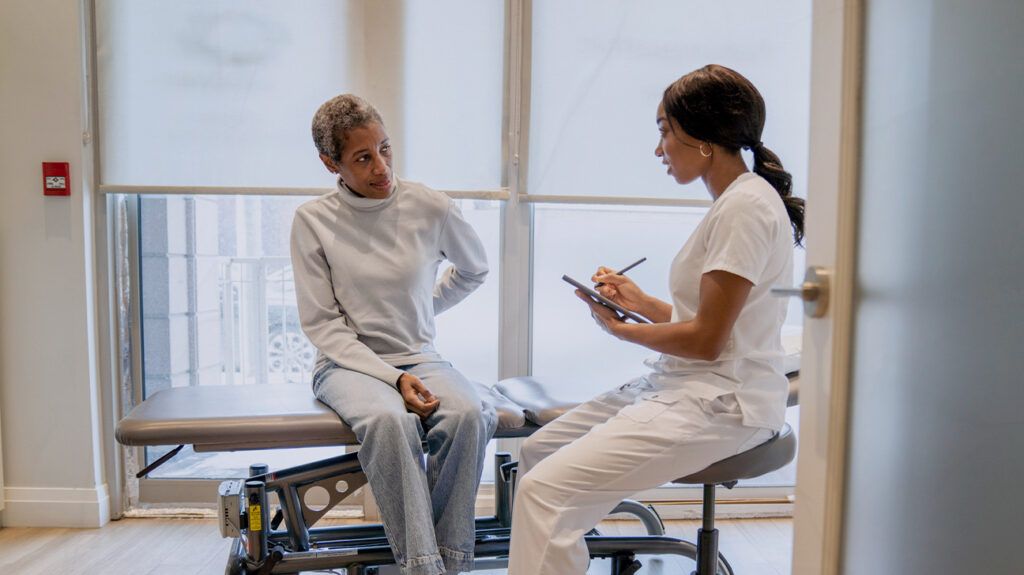Chiropractic treatment for overactive bladder (OAB) aims to realign the spine and improve bladder control. However, there is little scientific evidence to support the use of chiropractic care in treating OAB.
The spine plays a crucial role in transmitting nerve signals throughout the body, including those that control bladder function. Chiropractors believe misalignments in the spine — known as subluxations — can disrupt communication between the nervous system and the bladder and may contribute to urinary issues such as OAB.
Chiropractors aim to correct these misalignments and restore proper nerve function by applying specific spinal adjustments and manipulations. They claim this treatment improves bladder control and potentially reduces OAB symptoms. However, expert bodies such as the Urology Care Foundation do not list chiropractic care as a potential OAB treatment.
This article explores chiropractic treatment for OAB and examines the evidence supporting it as a complementary approach.

Chiropractors claim that correcting spinal misalignments using
Specifically, they suggest this type of treatment can:
- restore nerve function
- improve bladder control
- reduce OAB symptoms
The evidence supporting chiropractic care as an effective treatment for OAB is minimal. Still, anecdotal reports and case studies suggest positive outcomes for chiropractic treatment in general, with some people reporting
While a person may wish to consider chiropractic treatment as a complementary OAB treatment approach, more high quality research is necessary to establish its role in OAB management.
Current research
The existing studies are often small in scale, lack proper controls, and may not follow standardized protocols, making it challenging to use them to draw definitive conclusions.
For example, a small
Another small
- completely resolved in 10 people
- considerably improved in 7 people
- slightly improved in 4 people
Researchers also found these improvements remained stable over time.
While the idea of a misaligned spine causing OAB is plausible, the scientific evidence to support this claim is scarce. No direct evidence suggests that spinal misalignments cause OAB.
OAB is a complex condition with various potential underlying causes, such as bladder muscle dysfunction or nerve-related issues.
While chiropractic care may promote overall nervous system health, there is not robust scientific evidence to support attributing OAB solely to spinal misalignments.
It is best for individuals with OAB to consult their doctor before pursuing chiropractic care as a complementary treatment.
Chiropractic care may suit individuals experiencing mild OAB symptoms and seeking noninvasive or drug-free management options.
People with severe or debilitating OAB symptoms need immediate medical attention and should not rely solely on chiropractic care. Similarly, people with certain underlying medical conditions may not be suitable candidates to receive treatment from a chiropractor.
This might include people with the following:
- nerve-related disorders
- bladder abnormalities
- other serious health issues
Pregnant individuals with OAB symptoms will need to consult their obstetrician or gynecologist before considering chiropractic care. This is because specific chiropractic techniques may not be suitable during pregnancy.
Spinal manipulation is
These can include:
- soreness or discomfort
- stiffness
- headache
Serious complications
Rarely, serious complications can occur with chiropractic care.
These can include:
- nerve injury
- herniated discs
- strokes
- aggravation of preexisting spinal conditions
The risk of severe side effects may be greater in people with underlying health problems that raise their risk of injury.
It is important for individuals considering trying chiropractic care for OAB to discuss potential side effects and risks with their chiropractor and doctor. Before starting any treatment plan, a qualified chiropractor should thoroughly assess a person’s health and medical history.
The cost of chiropractic care for OAB
Generally, initial consultations and evaluations may incur separate fees from subsequent treatment sessions.
An initial chiropractic consultation can cost $50–$200 or more, while individual treatment sessions may cost $30–$200 per visit.
Some chiropractors offer discounted package rates for multiple sessions or provide payment plans to accommodate a person’s financial needs.
Insurance coverage
Insurance coverage for chiropractic care also varies significantly.
Some health insurance plans may provide partial coverage for chiropractic services, while others may not offer any coverage. Companies may also limit coverage to specific conditions or treatment approaches.
Therefore, a person with health insurance considering chiropractic treatment will need to review their policy carefully and contact their provider to determine their coverage for OAB management.
Learn about Medicare and chiropractic treatment.
Chiropractic care for overactive bladder (OAB) is a complementary therapy. It aims to address potential spinal misalignments that may affect bladder function. Chiropractors claim spinal adjustment can correct misalignments, restore proper nerve function, and potentially improve bladder control.
However, scientific research on the direct impact of chiropractic treatment on OAB is minimal. Current published studies have not established a definitive causal relationship between spinal misalignment and OAB.
It is important that people consult their doctor before pursuing chiropractic care for OAB. Things to consider before trying this therapy type include potential risks, side effects, and insurance coverage.
